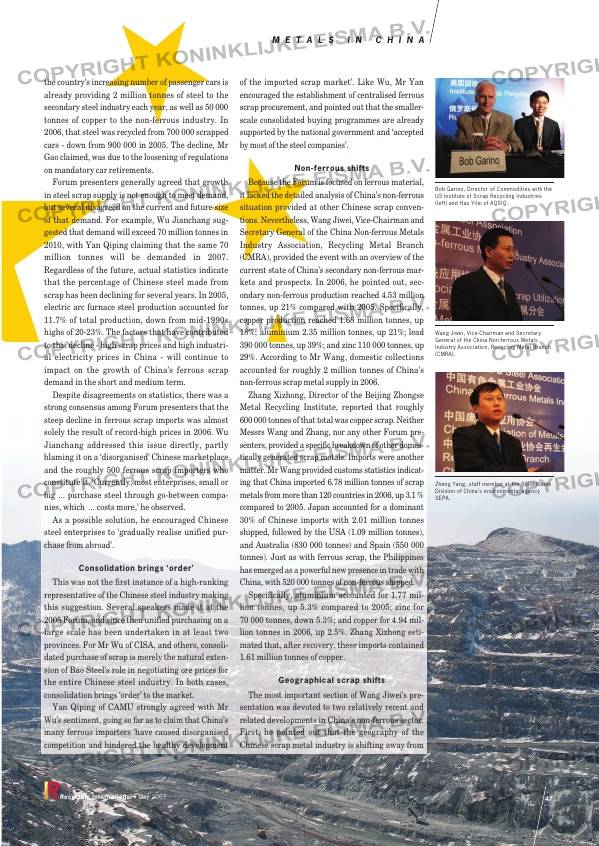Page 47 from: May 2007

the country’s increasing number of passenger cars is
already providing 2 million tonnes of steel to the
secondary steel industry each year, as well as 50 000
tonnes of copper to the non-ferrous industry. In
2006, that steel was recycled from 700 000 scrapped
cars – down from 900 000 in 2005. The decline, Mr
Gao claimed, was due to the loosening of regulations
on mandatory car retirements.
Forum presenters generally agreed that growth
in steel scrap supply is not enough to meet demand,
but several disagreed on the current and future size
of that demand. For example, Wu Jianchang sug-
gested that demand will exceed 70 million tonnes in
2010, with Yan Qiping claiming that the same 70
million tonnes will be demanded in 2007.
Regardless of the future, actual statistics indicate
that the percentage of Chinese steel made from
scrap has been declining for several years. In 2005,
electric arc furnace steel production accounted for
11.7% of total production, down from mid-1990s
highs of 20-23%. The factors that have contributed
to this decline – high scrap prices and high industri-
al electricity prices in China – will continue to
impact on the growth of China’s ferrous scrap
demand in the short and medium term.
Despite disagreements on statistics, there was a
strong consensus among Forum presenters that the
steep decline in ferrous scrap imports was almost
solely the result of record-high prices in 2006. Wu
Jianchang addressed this issue directly, partly
blaming it on a ‘disorganised’ Chinese marketplace
and the roughly 500 ferrous scrap importers who
constitute it. ‘Currently, most enterprises, small or
big … purchase steel through go-between compa-
nies, which … costs more,’ he observed.
As a possible solution, he encouraged Chinese
steel enterprises to ‘gradually realise unified pur-
chase from abroad’.
Consolidation brings ‘order’
This was not the first instance of a high-ranking
representative of the Chinese steel industry making
this suggestion. Several speakers made it at the
2005 Forum, and since then unified purchasing on a
large scale has been undertaken in at least two
provinces. For Mr Wu of CISA, and others, consoli-
dated purchase of scrap is merely the natural exten-
sion of Bao Steel’s role in negotiating ore prices for
the entire Chinese steel industry. In both cases,
consolidation brings ‘order’ to the market.
Yan Qiping of CAMU strongly agreed with Mr
Wu’s sentiment, going so far as to claim that China’s
many ferrous importers ‘have caused disorganised
competition and hindered the healthy development
of the imported scrap market’. Like Wu, Mr Yan
encouraged the establishment of centralised ferrous
scrap procurement, and pointed out that the smaller-
scale consolidated buying programmes are already
supported by the national government and ‘accepted
by most of the steel companies’.
Non-ferrous shifts
Because the Forum is focused on ferrous material,
it lacked the detailed analysis of China’s non-ferrous
situation provided at other Chinese scrap conven-
tions. Nevertheless, Wang Jiwei, Vice-Chairman and
Secretary General of the China Non-ferrous Metals
Industry Association, Recycling Metal Branch
(CMRA), provided the event with an overview of the
current state of China’s secondary non-ferrous mar-
kets and prospects. In 2006, he pointed out, sec-
ondary non-ferrous production reached 4.53 million
tonnes, up 21% compared with 2005. Specifically,
copper production reached 1.68 million tonnes, up
18%; aluminium 2.35 million tonnes, up 21%; lead
390 000 tonnes, up 39%; and zinc 110 000 tonnes, up
29%. According to Mr Wang, domestic collections
accounted for roughly 2 million tonnes of China’s
non-ferrous scrap metal supply in 2006.
Zhang Xizhong, Director of the Beijing Zhongse
Metal Recycling Institute, reported that roughly
600 000 tonnes of that total was copper scrap. Neither
Messrs Wang and Zhang, nor any other Forum pre-
senters, provided a specific breakdown of other domes-
tically generated scrap metals. Imports were another
matter. Mr Wang provided customs statistics indicat-
ing that China imported 6.78 million tonnes of scrap
metals from more than 120 countries in 2006, up 3.1 %
compared to 2005. Japan accounted for a dominant
30% of Chinese imports with 2.01 million tonnes
shipped, followed by the USA (1.09 million tonnes),
and Australia (830 000 tonnes) and Spain (550 000
tonnes). Just as with ferrous scrap, the Philippines
has emerged as a powerful new presence in trade with
China, with 520 000 tonnes of non-ferrous shipped.
Specifically, aluminium accounted for 1.77 mil-
lion tonnes, up 5.3% compared to 2005; zinc for
70 000 tonnes, down 5.3%; and copper for 4.94 mil-
lion tonnes in 2006, up 2.5%. Zhang Xizhong esti-
mated that, after recovery, these imports contained
1.61 million tonnes of copper.
Geographical scrap shifts
The most important section of Wang Jiwei’s pre-
sentation was devoted to two relatively recent and
related developments in China’s non-ferrous sector.
First, he pointed out that the geography of the
Chinese scrap metal industry is shifting away from
Recycling International • May 2007 47
M E T A L S I N C H I N A
Bob Garino, Director of Commodities with the
US Institute of Scrap Recycling Industries
(left) and Hao Yilei of AQSIQ.
Wang Jiwei, Vice-Chairman and Secretary
General of the China Non-ferrous Metals
Industry Association, Recycling Metal Branch
(CMRA).
Zheng Yang, staff member at the Solid Waste
Division of China’s environmental agency
SEPA.
RI_029 China-Dalian Congress:Opmaak 1 02-05-2007 12:01 Pagina 47



